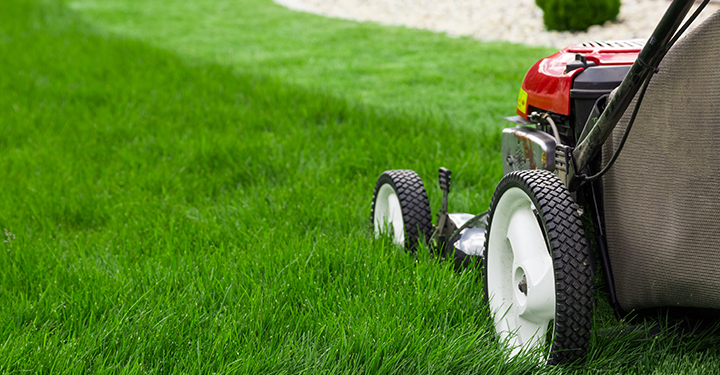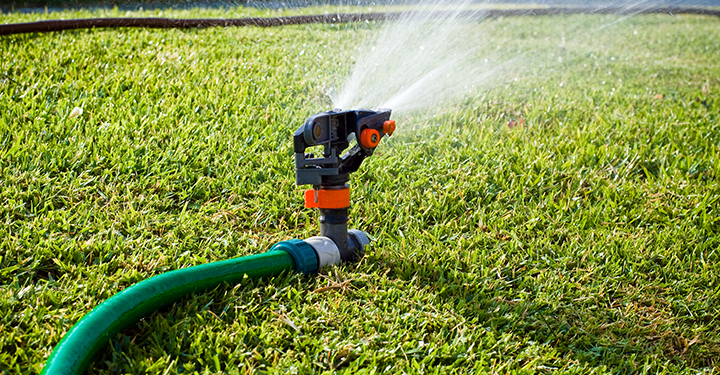Lawn Mowing Tips
Mow High – The most important lawn tip we can give you is to mow high. The blade of your grass should stand around 3″-4″ high after being cut. Many people like to mow their lawns like it is a fairway on a golf course.
This is the worst thing you can do for the turf and root system. Mowing higher will encourage a thicker lawn to be created, which will prevent weed seeds from reaching the soil to germinate. Also, sunlight is the food source for grass blades and weeds.
By having a thicker higher grass you can potentially crowd out weeds by the blades of grass stealing their food source (sunlight). Mowing your lawn down to short lengths will make lawns more prone to unwanted things such as crabgrass and heat stress.
The longer grass blades provide a greater area for photosynthesis to occur, which can help store carbohydrates for future use during droughts. These grass blades also keep the soil temperature cooler. Mowing height should be slightly decreased to 2″-2.5″ for the last few mowings in the fall. Mowing high is a must with organic lawn care.


How To Mow
Mow your grass in different directions to make sure it is being cut correctly. This will help the grass blade to stand erect instead of being pushed over.
This rule states that you should never cut more than 1/3 of grass blade in one mowing session. By cutting off more than this you can actually stunt the root growth for up to 30 days.
Don’t bag your grass clippings. Mulching your grass clippings and allowing them to absorb back into the soil is a great source of extra organic matter. These grass clippings feed earthworms and naturally add nutrients to the soil. AVOID CLUMPS. If you start getting clumps bag them, spread them out, or rake them up. Clumps can damage the lawn. If you are experiencing clumping you are either mowing too short or infrequently.
You should sharpen your mower blade at least once a year. A dull mower blade will tear the blades of the grass instead of cutting. This tearing will not only shred the top growth of the blade causing it to turn brown much easier, but will also leave it vulnerable to lawn diseases.
When you mow the lawn when it is wet it is very easy for small areas of disease to be spread throughout the lawn. Also, the grass blades will be torn rather than cut leaving the grass blade vulnerable to diseases through the tear. Finally, cutting the grass when it is wet will cause the grass to clump up much easier, which can be damaging to a healthy lawn.
Lawn Watering Tips
The best time to water is in the early morning. The middle of the day is not efficient because many times the sunlight will evaporate the moisture before it gets a chance to absorb. In the evenings, watering is bad because the water tends to cling onto the blades and stay there overnight. This will invite many types of lawn diseases to take over the lawn. Avoid watering in the evening after 3:00 P.M. to avoid lawn diseases. If this is inconvenient during the week then wait until the weekend to water the lawn.
When you see your grass blades starting to curl that means they are about to start turning brown. This is the lawn telling you to give it some water. Another sign is when you walk through your lawn, blades don’t bounce back up, and you can see your footprint…The lawn needs some water!
The lawn needs about an 1-2 inches of water per week. This usually means about 1-1.5 hrs. per spot every 4-7 days. During the spring and fall the rain usually provides this. During the summer or dry periods, you can either let the lawn naturally go semi-dormant or provide the inch of water. Lawns are resilient, but still need an inch of water per month or they will die. During droughts, like in 2007, make sure the lawn is getting at least an inch of water per month so it will bounce back in the fall.
Watering everyday is not good, and actually encourages a shallow root system and invites disease problems. You want to water deeply and infrequently (remember every 4-7 days for 1-1.5 hrs. per spot). The goal from this method of watering is to train the roots to dive deep into the ground between waterings to develop deeper, stronger roots. This will result in the grass to be able to handle stresses much better and reduce your water bill.
If new seed is down always keep the soil moist, but do not allow runoff to occur. Keep it moist, but not soaked. Water ¼ inch per day spaced out, never allowing it to become dry. Once the grass blade reaches 2-3 inches return to watering deeply and infrequently.
